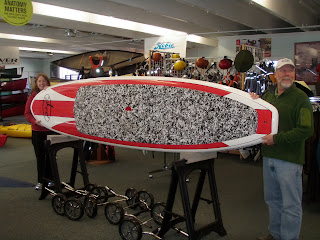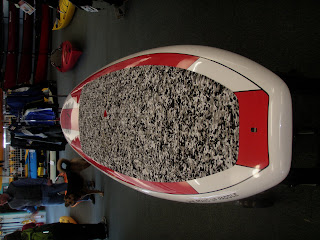




New at Idaho River Sports this year is Supin'!
They also pioneered the art of stand-up paddleboarding — also known as stand-up paddle surfing or beach-boy surfing — now all the rage among fitness enthusiasts and practiced from Cape Cod to Cape Town.
In San Francisco, where I live and surf, there’s almost always a stand-up paddleboarder in the lineup on any given morning. On days when there aren’t many waves, I envy the cruise-y ease of the paddleboarder as he maneuvers through flat water, getting exercise all the while. On a recent trip to Honolulu I decided to try stand-up paddleboarding in its birthplace.
First, I sought inspiration in the archives of the venerable Bishop Museum, founded in 1889 in honor of Princess Bernice Pauahi Bishop, the last descendant of the royal Kamehameha family. The museum has a renowned collection of natural and cultural artifacts from Hawaii and the Pacific Islands. Surfboards were once exclusively the province of royalty; the museum’s holdings include 19th-century wooden boards that belonged to chiefs and princesses, as well as other models that were used by the legendary surfer Duke Kahanamoku and first introduced at Waikiki.
The Waikiki beach boys began using outrigger canoe paddles with surfboards in the 1960s, as a way to keep an eye on their tourist charges and to get better pictures as the beginners made their first attempts at wave riding. Ask locals about stand-up paddleboarding, and many will reminisce about the first time they saw someone do it.
“I remember this one guy, he wore a construction helmet and had a cigar clamped in his teeth,” Charles Myers, an archivist at the Bishop Museum, told me as he brought out vintage black-and-white photos of Waikiki. “He used a paddle and stood up on this big, floaty tandem board to see above the water when he was teaching people to surf.”
As I examined photographs of fit young men surfing, swimming and paddling canoes — and even giving ukulele lessons to women on the beach — I thought of the tradition of the “waterman,” the athletic and aesthetic ideal to which ancient Hawaiian men aspired. The beach boys, the modern epitome of watermen, found joy in every kind of water sport and helped to popularize surfing as we know it.
One of the most famous was George Freeth, an accomplished swimmer and lifeguard who was the subject of a profile by Jack London in 1907. Freeth, who moved to California and became known as a pioneer of modern surfing, was awarded a Congressional medal for rescuing several fishermen during a treacherous storm in 1908.
What began as a matter of practicality for the beach boys started popping up in its modern form as a full-fledged sport in the past 5 to 10 years; there are now stand-up paddleboarding competitions all over the world, from flat-water races on rivers and lakes to big-wave ocean contests. Since the boards are large and stable in flat water, they are easy to use.
Hotels around Honolulu have capitalized on the craze; many now offer stand-up paddleboarding lessons. For my maiden voyage I ventured into the calm turquoise lagoon at the Kahala Hotel & Resort, which looks out at the Diamond Head and Koko Head craters.
The afternoon sun glinted off the water as I stood uncertainly in the warm shallows with the relevant equipment — thick 10-foot board, long, angled paddle — I’d just rented from Kahala’s beach shack. The attendant reassured me that there was nothing to it.
“Hop on the board, start on your knees and try paddling from that stance first,” he instructed, mimicking the motions as he talked. “Keep the flat of the paddle to the back when you stroke. Then try standing up, keeping your weight to the center of the board and legs slightly apart.” He paused. “That’s it.”
Oh, and one last bit of advice.
“You might want to stay away from the waves for now,” he called as I began to paddle away. “And fall shallow!”
The paddling part was easy. As I skimmed across the water, I noted how clear it was: I could see fish, seaweed-covered rocks and the wide expanse of white sand before it met the coral bank offshore. I wanted to see even more. So I tried, gingerly at first, to stand, laying the paddle across the board for stability. With a few wobbles, I was up, sea legs found.
No comments:
Post a Comment